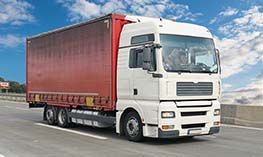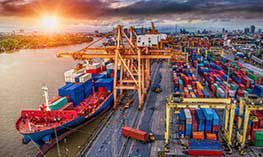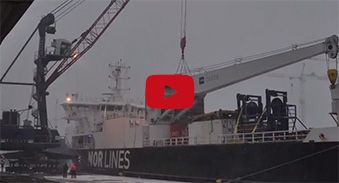The forwarding industry, like any technical industry, contains a number of phrases and definitions reserved only for a small group of specialists. Below we present a list of the most frequently used and also specialized phrases used in the logistics industry, i.e. the handy TFL glossary.
TFL GLOSSARY, OR LIST OF TERMS USED IN THE INDUSTRY
ADR (from French L 'Accord européen relatif au transport international des marchandises Dangereuses par Route) – international convention on the transport of dangerous goods. They include: explosives and materials, gases, flammable liquids, radioactive materials, corrosive materials, other hazardous materials and objects.
CBM (cubic meter) or unit of measure denoting cubic meters.
CFS (Container Freight Station) – container ship. During export: a base where customers accept loads smaller than the container (LCL) for packing in containers. When imported, loads are unpacked from the containers and delivered to customers.
CIF (Cost Insurance and Freight) – cost, insurance and transport. Incoterm CIF is exactly the same as incoterm CFR, with the only difference that the seller additionally pays insurance for the goods during transport.
CRM (customer relationship management) – a set of procedures and tools important in managing contacts with clients. The system used by forwarders is SpedTrans.
CY (container yard) – container terminal in a seaport – place of loading containers onto the ship.
DCT Gdańsk (Deepwater Container Terminal Gdańsk) – container terminal in the seaport of Gdańsk.
DGR (from Dangerous Goods Regulations) – hazardous materials, specifically a set of provisions for their transport. Abbreviation used include in air transport.
DMC – permissible total weight. The total mass of the vehicle or combination of vehicles together with the mass of load declared as acceptable by the competent authorities.
D2D (door to door) – a term specifying full forwarding service, from the moment of picking up the goods at the sender until delivery of the goods to the recipient. The service in D2D mode includes completing all necessary formalities by the forwarder.
ETA (estimated time of arrival) – approximate loading time.
EXW (ex works) – defines the terms of delivery in maritime transport, otherwise known as the 'ex-works’ formula. The seller leaves the goods at the buyer’s disposal at the point of release (warehouse, plant). His duties include neither customs clearance of goods nor loading of goods onto a means of transport. In the case of EWX, the buyer arranges the transport, bears its costs and risk along the entire route.
FCL (Full Container Load) – Container fully filled – a term used when transporting containers from China by sea. It means that the entire container is used by one recipient.
FEU (forty feet equivalent unit) – unit of capacity equivalent to the volume of a 20-foot container.
FIFO (first in – first out) – the queue method or the earliest price method, is a method of valuation of products in the warehouse and their outgoing, consisting in posting the outgoing from the unit of goods that was received at the earliest.
FT / FTR (flatrack) – flat platforms for transporting oversized or out of gauge (OOG) loads.
FOB (free on board) – Incoterm is one of the delivery conditions only for sea transport. In this case, the goods shall be deemed to have been delivered after being loaded onto the ship indicated by the buyer in the seller’s home port.
FTL (Full Truck Load) – Full load, whole vehicle shipments – the load covers the entire surface of the truck or semi-trailer. FTL transport ensures maximum utilization of the load space. Currently, the maximum load volume in road transport is 38 Euro-pallets and 24 tonnes.
FV – VAT invoice.
GDP (Good Distribution Practice) or Good Distribution Practice. Meeting the requirements of Good Distribution Practice is the responsibility of the company that participates in the supply chain of medicinal products on the territory of Poland and the European Union.
HACCP (Hazard Analysis and Critical Control Points) – is to guarantee the safety of storage and distribution of food products. HACCP. An organizational system created for the functioning of the company in a way that excludes contamination or contamination of food products, guaranteeing consumer safety when proceeding in accordance with the requirements for a given food product.
HC (high cube container) – tall container with dimensions 8 ′ X 9-1 / 2 ′ X 40.
HDS (hydraulic truck crane) – loading crane, i.e. truck transport with a crane. A truck with a crane mounted on it (called a loading crane) enabling self loading and unloading of this vehicle (sometimes also called a loading crane). Usually it has a carrying capacity of several tons.
IATA (The International Air Transport Association) – The International Air Transport Association – a global trade organization based in Montreal and Geneva, which brings together 260 carriers using airlines today.
Incoterms – international trade formulas developed by the International Chamber of Commerce in Paris. Widely used in foreign trade. EXW, FCA, CPT, CIP, DAT, DAP, DDP are formulas applicable to all transport branches – the place of delivery / destination is indicated in them. FAS, FOB, CFR, CIF are used in maritime and inland transport.
I.S.O. (in shipper owned tank) – in own container / cistern; (also used T.S.O.)
ISO (International Organization for Standardization) – The International Organization for Standardization, was founded in 1946 in London.
JIT (just in time) – the just-in-time method (in literal translation: just in time, exactly on time) consists in providing materials needed to produce products or services exactly in the amount that the company needs, and exactly in as long as they are needed. The main purpose of this method is therefore to reduce inventories to the necessary minimum, optimizing supplies.
ATA carnet (French: Admission Temporaire) – an international customs document that enables and facilitates customs clearance of goods temporarily exported, e.g. for acquisition or exhibition purposes. The issuing and use of ATA carnets is governed by the Convention on Temporary Customs Clearance signed in Istanbul on July 26, 1990.
ATP Convention – Agreement on the international transport of perishable foodstuffs and on special means of transport intended for such transport, done on 1 September 1970 in Geneva (Poland ratified it in 1984). The signing of the contract was aimed at improving the conditions for the transport of perishable foodstuffs.
CMR Convention (convention Convention relative au contrat de transport international de marchandises par route, ang. Convention on the Contract for the International Carriage of Goods by Road) – a convention signed in 1956 in Geneva. It applies in the case of commercial road transport of goods in international relations.
LDM (loading meter). 1ldm = 2.4m x 1m = 2.4 m2. Note: The load meter should not be confused with running or square meters.
LCL (Less then Container Load) – less than the container volume – determines the transport of groupage shipments. During LCL transport, only part of the container loading space is used.
LIFO (last in – first out) – the latest price method, is a method of valuation of products in the warehouse and their outgoing, consisting in accounting of outflows starting from the last unit accepted into the warehouse.
LO-LO (lift on – lift off) – lo-lo type vessels are container containers, which are transhipped vertically.
LTL (Less Than Truckload) – less than the total loading area. The term used in road transport refers to a load that only occupies part of the space available on the car’s semi-trailer.
MSC Maya – one of the world’s largest container ships measuring 395.5 meters long and 54 meters wide.
MM – Interbranch transfer. Warehouse document.
OPWS (General Polish Forwarding Conditions) – apply in relations between the forwarder and his principal. OPWS consists of 31 paragraphs. OPWS defines the rights and obligations of the parties to the forwarding contract, however, it should be remembered that they are not a legal provision and do not constitute a source of law. In some cases, the OPWS regulations are even contrary to the Civil Code or the CMR.
OT (open top container) – a container that has an open top covered by a tarpaulin instead of a fixed roof.
POD (proof of delivery) – delivery confirmation document.
Project Cargo – a term used to describe national or international transport of large, heavy and valuable items.
PZ – Goods receipt from outside. Warehouse document.
PW – Internal goods receipt. Warehouse document.
RO-RO (roll-on / roll-off) – horizontal ship transhipment system, consisting of rolling in and rolling loads through ship’s sides.
RW – Inward expenditure. Warehouse document.
SPMT (self-propelled modular transporter) – a transporter with a platform with a large set of wheels, used to transport oversized (loads up to 15,000 tons).
TEU (twenty feet equivalent unit) – a unit of capacity often used for ports and ships, is equivalent to the volume of a 20-foot container.
Railway terminal – a logistics complex with buildings and devices enabling loading, unloading, transhipment and storage of goods delivered by rail. In the terminal, it is also possible to assemble freight trains and integrate logistics and transport services.
Małaszewicze Terminal – a railway terminal of strategic international importance, occupying the largest free zone in Poland. The terminal belongs to the PKP Cargo company, consists of five smaller terminals. It is the main entry point from the New Silk Road to Europe.
TIR – (fr. Transport International Routier) – the international customs convention of November 14, 1975 concerning the transport of goods by trucks in international transport, allowing simplification of procedures at border crossing points and at customs offices in order to increase the efficiency of road transport.
TFL – Transport – Forwarding – Logistics. An abbreviation describing the transport industry in Poland.
WCA – (World Cargo Alliance) – the largest network of independent forwarding companies in the world, associating forwarding companies from 190 countries. Its task is to facilitate cooperation between members and introduce innovative solutions to the TSL industry.
WP – Production release. Warehouse document.
WZ – external edition. The WZ document is a very often used receipt in warehouses. It is used when the goods are released from the company (hence the name, release of materials outside).






